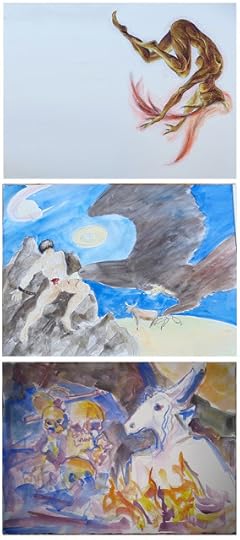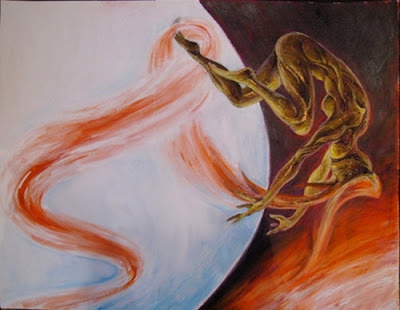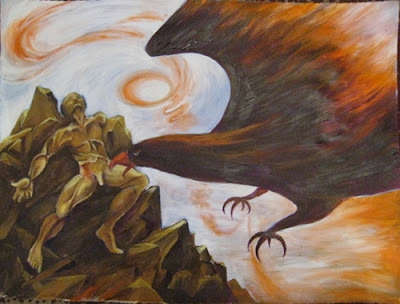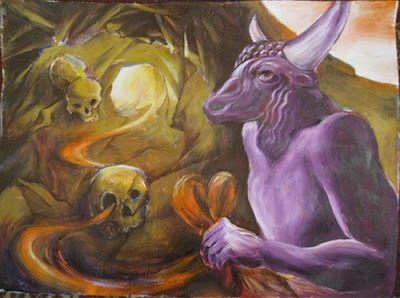Can We Inspire Each Other?
This is a story of collaboration between three artists: Albert Setton, Ettore Andreani, and yours truly, combining forces to create a single, cross-inspired project. In the beginning, we decided that each one of us will crawl back into his or her cave to create an initial sketch. What would it be about? We didn't know at first, but because we share an affinity to mythological themes, we agreed to have the sketch refer to one of the stories in Greek mythology. Also, we decided on the overall size of the paper; so by the time we met, we had three art pieces, each 30"x24".
Next we had to make a decision how to put the three pieces together. Would they be placed side-by-side, like an altar triptych? In what order? Should we cut and paste pieces of them together, to create a new whole? Or should they be arranged in a vertical column? Who's on top?
Stacking the pieces vertically seemed appropriate, because my piece--a figure floating in space like Dedalus who lost his wings getting too close to the sun--lends itself to be up there above the rest. It is a metaphor for my own fragility; indeed, the fragility of all of us who dream of soaring... The middle piece, painted by Ettore Andreani, describes the plight of Prometheus, doomed for eternal suffering for daring to give fire, which is divine, to mortals. Down below, Albert Setton's piece, depicting the Minotaur in his cave, which is perhaps the way he views himself. This piece lends itself to be underground.

Now we had to combine the three pieces--not only graphically (by eliminating superfluous detail and adjusting the overall composition) but also in terms of the overall narration. This we did using Ariadne's thread, which runs through all three panels, twisting and turning through them. We decided on the following narrative scheme:
Top panel:
Ariadne is seen dancing with the thread, which connects the three panels together.
Middle panel:
Here, the eagle itself is the blazing fire of the gods, the same fire the gods wish to deny us, mortals.
Bottom panel:
Here, the Minotaur is waiting for Theseus, his slayer, while holding the end of Ariadne's thread.



The Minotaur, a creature part man, part bull, lived at the center of the Labyrinth until it was killed by Theseus. On his arrival in Crete, Ariadne fell in love with Theseus and gave him a ball of thread, so he could find his way out of the Labyrinth. She is seen above, dancing with the thread, which connects the panels together. Prometheus stole fire from the gods and gave it to mortals. He was punished by being bound to a rock while a great eagle ate his liver, only to have it grow back to be eaten again the next day. Here, the eagle itself is the blazing fire of the gods.
I let the Minotaur hold the end of Ariadne's thread. He knows his fate. Perhaps he is waiting, with a philosophical look of acceptance, for his slayer to come in, following the trail of blood, and the remains of all his victims. Death is imminent...
But alas, in this entire three-panel painting, the slayer is missing. Instead all we see is Prometheus chained on the rock, and no one else is visible to bring an end to the endlessly waiting Minotaur.

Next we had to make a decision how to put the three pieces together. Would they be placed side-by-side, like an altar triptych? In what order? Should we cut and paste pieces of them together, to create a new whole? Or should they be arranged in a vertical column? Who's on top?
Stacking the pieces vertically seemed appropriate, because my piece--a figure floating in space like Dedalus who lost his wings getting too close to the sun--lends itself to be up there above the rest. It is a metaphor for my own fragility; indeed, the fragility of all of us who dream of soaring... The middle piece, painted by Ettore Andreani, describes the plight of Prometheus, doomed for eternal suffering for daring to give fire, which is divine, to mortals. Down below, Albert Setton's piece, depicting the Minotaur in his cave, which is perhaps the way he views himself. This piece lends itself to be underground.

Now we had to combine the three pieces--not only graphically (by eliminating superfluous detail and adjusting the overall composition) but also in terms of the overall narration. This we did using Ariadne's thread, which runs through all three panels, twisting and turning through them. We decided on the following narrative scheme:
Top panel:
Ariadne is seen dancing with the thread, which connects the three panels together.
Middle panel:
Here, the eagle itself is the blazing fire of the gods, the same fire the gods wish to deny us, mortals.
Bottom panel:
Here, the Minotaur is waiting for Theseus, his slayer, while holding the end of Ariadne's thread.



The Minotaur, a creature part man, part bull, lived at the center of the Labyrinth until it was killed by Theseus. On his arrival in Crete, Ariadne fell in love with Theseus and gave him a ball of thread, so he could find his way out of the Labyrinth. She is seen above, dancing with the thread, which connects the panels together. Prometheus stole fire from the gods and gave it to mortals. He was punished by being bound to a rock while a great eagle ate his liver, only to have it grow back to be eaten again the next day. Here, the eagle itself is the blazing fire of the gods.
I let the Minotaur hold the end of Ariadne's thread. He knows his fate. Perhaps he is waiting, with a philosophical look of acceptance, for his slayer to come in, following the trail of blood, and the remains of all his victims. Death is imminent...
But alas, in this entire three-panel painting, the slayer is missing. Instead all we see is Prometheus chained on the rock, and no one else is visible to bring an end to the endlessly waiting Minotaur.
Published on June 10, 2012 15:20
No comments have been added yet.



